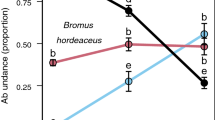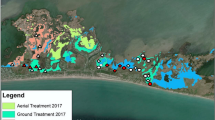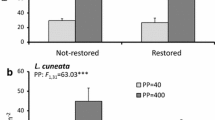Abstract
Disturbances that intensify with agriculture and/or urban development are thought to promote the spread of invasive plants, such as the clonal perennial reed canary grass ( Phalaris arundinacea L). To test this relationship and interactions among disturbances, we subjected wet prairie assemblages within 1.1 m2 mesocosms to invasion by Phalaris and addition of nutrients, sediments, and flooding. Species richness decreased with the application of sediments and/or flooding of 4 consecutive weeks or longer. Losses of up to six dominant and subdominant species in these treatments increased light transmission through the plant canopy by as much as 400% over the control. Light availability in July and September was a strong predictor of end-of-season aboveground biomass of Phalaris. Phalaris was also 35% and 195% more productive when nutrients were added at low and high levels, respectively. Multiple factors in combination were usually additive in their effects on invasion, but sediments and nutrients interacted with flood regime to synergistically increase invasion in some cases. A separate experiment likewise revealed a synergistic interaction between added nutrients and simulated grazing. We suggest that multiple factors be mitigated simultaneously to reduce invasion of Phalaris.






Similar content being viewed by others
References
Burke MJW, Grime JP (1996) An experimental study of plant community invasibility. Ecology 77:776–790
Cottam G, Wilson HC (1966) Community dynamics of an artificial prairie. Ecology 47:88–96
Crawley MJ (1987) What makes a community invasible? In: Gray AJ, Crawley MJ, Edwards PJ (eds) Colonization, succession, and stability. Blackwell Scientific, London, UK, pp 429–453
Curtis JT (1959) The vegetation of Wisconsin. University of Wisconsin Press, Madison, Wis., USA
Davis MA, Grime JP, Thompson K (2000) Fluctuating resources in plant communities: a general theory of invasibility. J Ecol 88:528–534
Day JW, Pieczynska E, Úlehlová B (1998) Further fate of organic matter in wetlands. In: Westlake DF, Kvêt J, Szczepánski A (eds) The production ecology of wetlands. Cambridge University Press, Cambridge, UK, pp 169–191
De Kroon H, Bobbink R (1997) Clonal plant dominance under elevated nitrogen deposition, with special reference to Brachypodium pinnatum in chalk grassland. In: de Kroon H, van Groenendael J (eds) The ecology and evolution of clonal plants. Backhuys, Leiden, the Netherlands, pp 359–379
Diboll N (1996) Designing seed mixes. In: Packard S, Mutel CF (eds) The tallgrass restoration handbook. Island, Washington, D.C., USA, pp 135–149
Elton CS (1958) The ecology of invasions by animals and plants. Methuen, London, UK
Ewing K (1996) Tolerance of four wetland plant species to flooding and sediment deposition. Environ Exp Bot 36:131–146
Fassett NC (1951) Grasses of Wisconsin. University of Wisconsin Press, Madison, Wis., USA
Galatowitsch SM, Anderson NO, Ascher PD (1999) Invasiveness in wetland plants in temperate North America. Wetlands 19:733–755
Galatowitsch SM, Whited DC, Lehtinen R, Husveth J, Schik K (2000) The vegetation of wet meadows in relation to their land-use. Environ Monit Assess 60:121–144
Green EK, Galatowitsch SM (2002) Effects of Phalaris arundinacea and nitrate-N addition on the establishment of wetland plant communities. J Appl Ecol 39:134–144
Hobbs RJ, Atkins L (1988) Effect of disturbance and nutrient addition on native and introduced annuals in plant communities in the Western Australia wheat belt. Aust J Ecol 13:171–179
Huenneke LF, Hamburg SP, Koide R, Mooney HA, Vitousek PM (1990) Effects of soil resources on plant invasion and community structure in Californian serpentine grassland. Ecology 71:478–491
Larson, DL, Anderson PJ, Newton W (2001) Alien plant invasion in mixed-grass prairie: effects of vegetation type and anthropogenic disturbance. Ecol Appl 11:128–141
Lindig-Cisneros RA, Zedler JB (2002a) Phalaris arundinacea seedling establishment: effects of canopy complexity in fen, mesocosm, and restoration experiments. Can J Bot 80:617–624
Lindig-Cisneros RA, Zedler JB (2002b) Relationships between canopy complexity and germination microsites for Phalaris arundinacea L. Oecologia 133:159–167
Maurer DA, Zedler JB (2002) Differential invasion of a wetland grass explained by tests of nutrients and light availability on establishment and vegetative growth. Oecologia 131:279–288
Maurer DA, Lindig-Cisneros R, Werner KJ, Kercher S, Miller R, Zedler JB (2003) The replacement of wetland vegetation by reed canary grass ( Phalaris arundinacea). Ecol Restor 21:116–119
McCune B, Grace JB (2002) Analysis of ecological communities. MjM Software, Gleneden Beach, Oregon, USA
McCune B, Mefford MJ (1997) Multivariate analysis of ecological data, version 3.14. MjM Software, Gleneden Beach, Oregon, USA
Morrison SL, Molofsky J (1998) Effects of genotypes, soil moisture, and competition on the growth of an invasive grass, Phalaris arundinacea (reed canary grass). Can J Bot 76:1939–1946
Patrick WH, Gambrell RP, Faulkner SP (1996) Redox measurements of soils. In: Sparks DL, Page AL, Helmke PA, Loeppert RH, Foltanpour PN, Tabatabai MA, Johnston CT, Sumner ME, Bartels JM, Bingham JM (eds) Methods of soil analysis. (Part 3, Chemical Methods, Series 5) Soil Science Society of America and American Society of Agronomy, Madison, Wisconsin, USA, pp 1255–1273
Rejmánek M (1989) Invasibility of plant communities. In: Drake JA, et al (eds) Biological invasions: a global perspective. Wiley, Chichester, UK, pp 369–388
SAS (1999) SAS Version 8.0. Cary, N.C., USA
USDA, NRCS (2002) The PLANTS Database, Version 3.5 (http://plants.usda.gov). National Plant Data Center, Baton Rouge, Louisiana, USA
Van der Valk AG (2000) Vegetation dynamics and models. In: Murkin HR, van der Valk AG, Clark WR (eds) Prairie wetland ecology. Iowa State University Press, Ames, Iowa, USA, pp 125–161
Vermeer JG, Berendse F (1983) The relationship between nutrient availability, shoot biomass and species richness in grassland and wetland communities. Vegetatio 53:121–136
Watson VJ, Loucks OL, Wojner W (1981) The impact of urbanization on seasonal hydrologic and nutrient budgets of a small North American watershed. Hydrobiologia 77:87–90
Werner KJ, Zedler JB (2002) How sedge meadow soils, microtopography, and vegetation respond to sedimentation. Wetlands 22:451–466
Woo I, Zedler JB (2002) Can nutrients alone shift a sedge meadow towards dominance by the invasive Typha × glauca? Wetlands 22:509–521
Acknowledgements
This research was supported by EPA-STAR (Science to Achieve Results) grant number R-82801001–0 (Richard Lathrop and Ken Potter, principal investigators). We thank the Anna Grant Birge Memorial Award committee for additional funding, the Walnut St. Greenhouse staff, the Arboretum Leopold Endowment for providing mesocosm facilities, Andrea Herr-Turoff, Philip Kurle, Debbie Maurer, Becky Miller, Hem Nalini Morzaria-Luna, Roberto Lindig-Cisneros, Katy Werner, Dan Larkin, Julia Wilcox, and Tom Brow for assistance in setting up the mesocosms and collecting data.
Author information
Authors and Affiliations
Corresponding author
Rights and permissions
About this article
Cite this article
Kercher, S.M., Zedler, J.B. Multiple disturbances accelerate invasion of reed canary grass ( Phalaris arundinacea L.) in a mesocosm study. Oecologia 138, 455–464 (2004). https://doi.org/10.1007/s00442-003-1453-7
Received:
Accepted:
Published:
Issue Date:
DOI: https://doi.org/10.1007/s00442-003-1453-7




